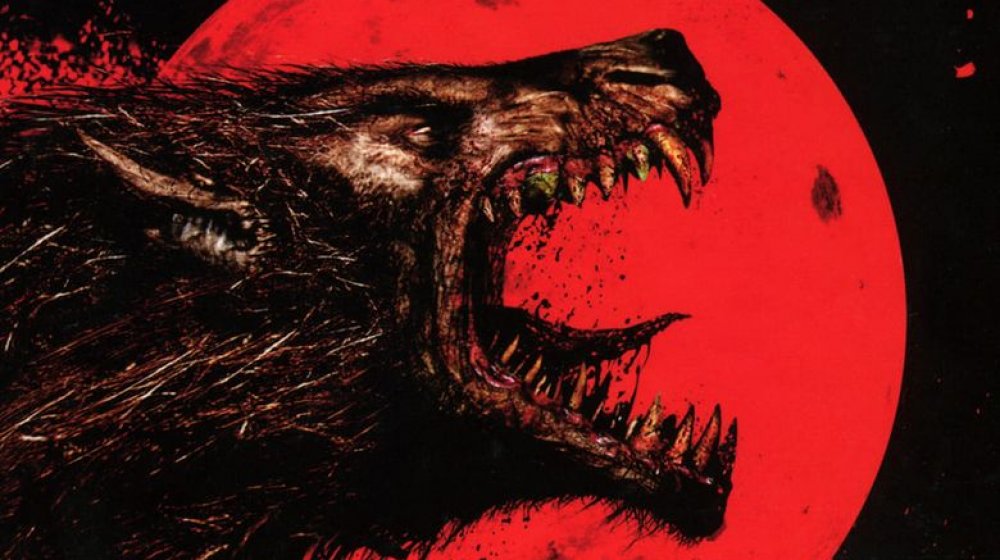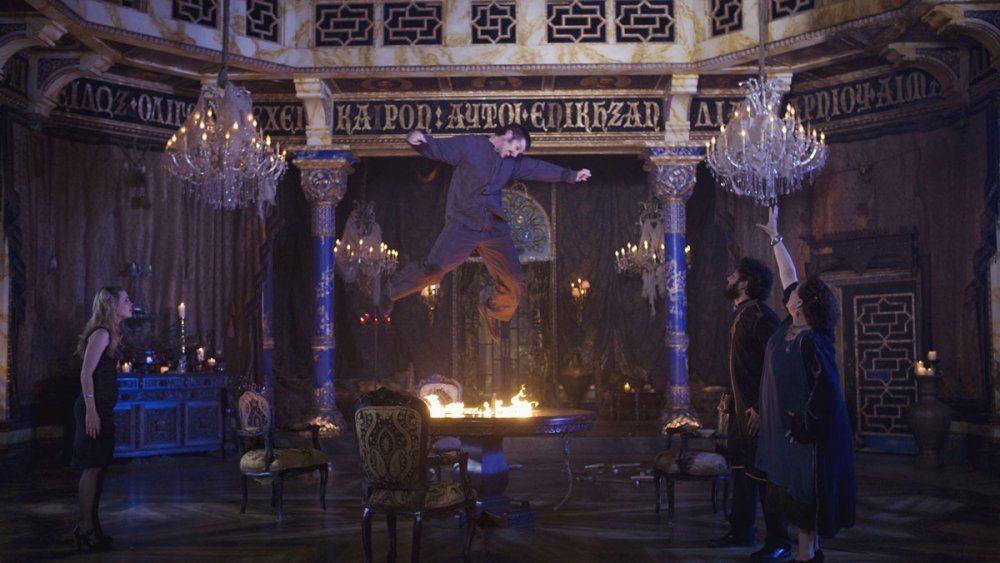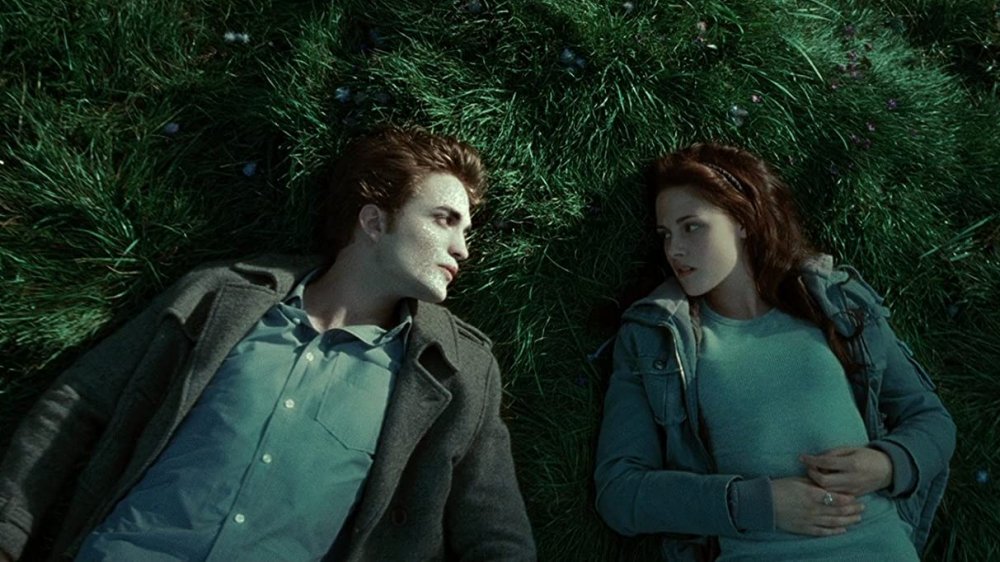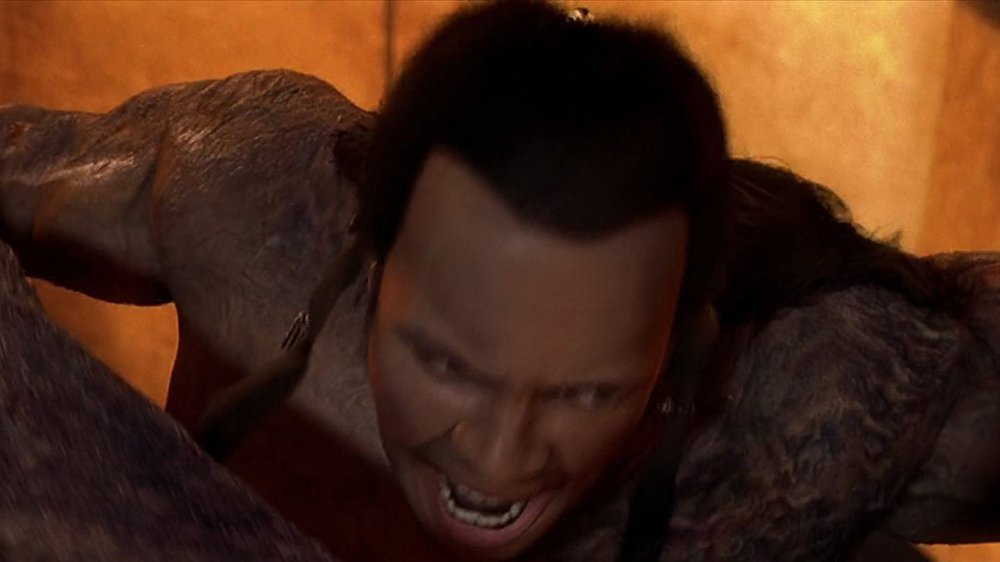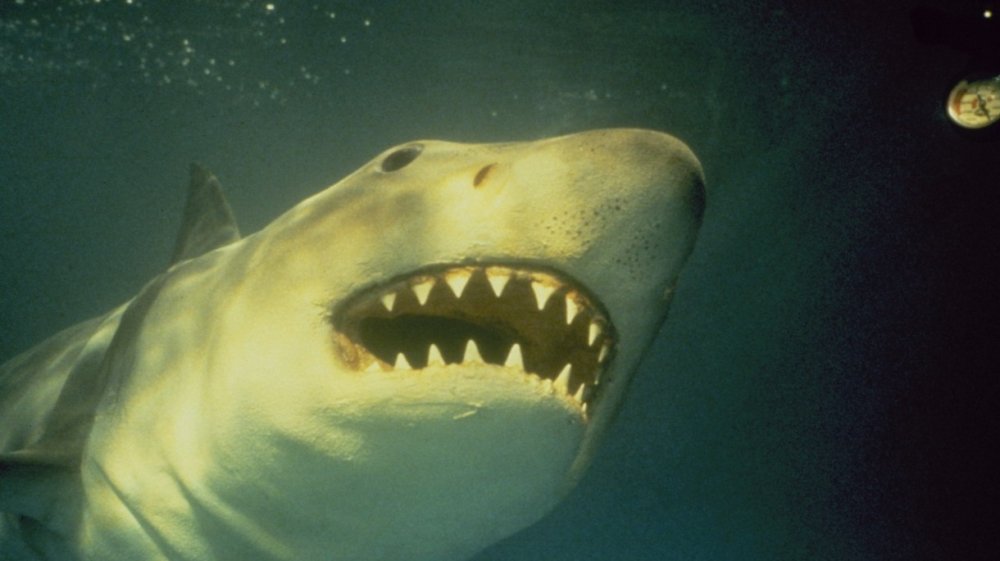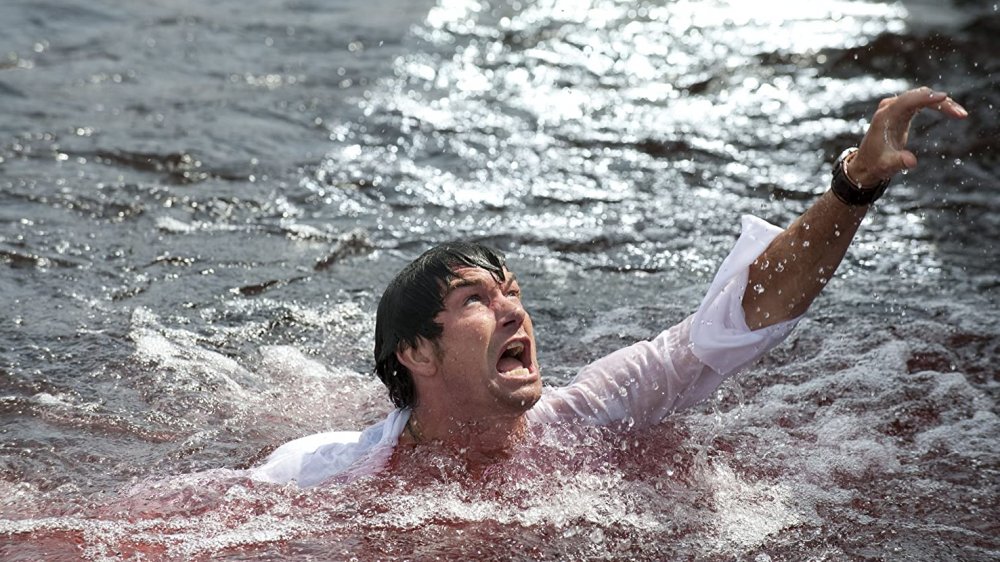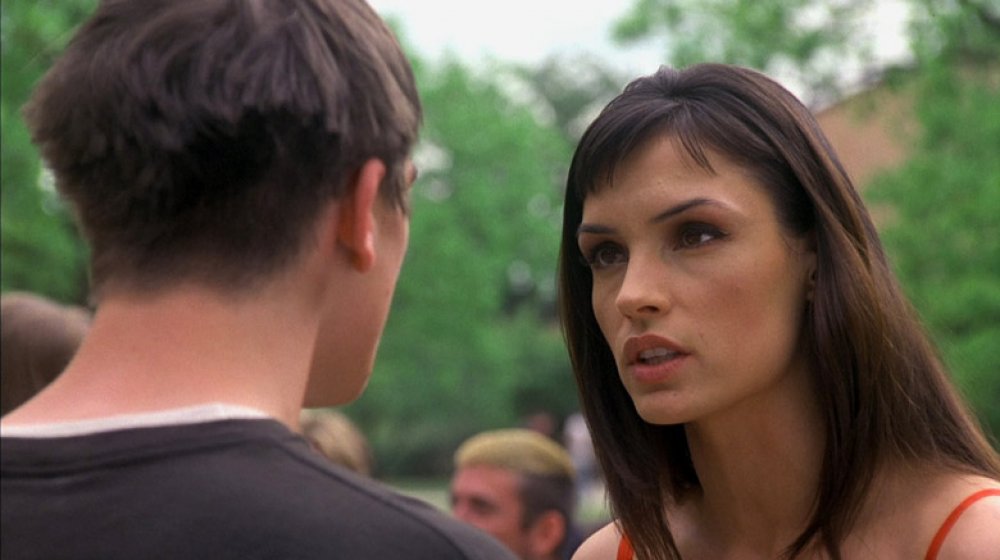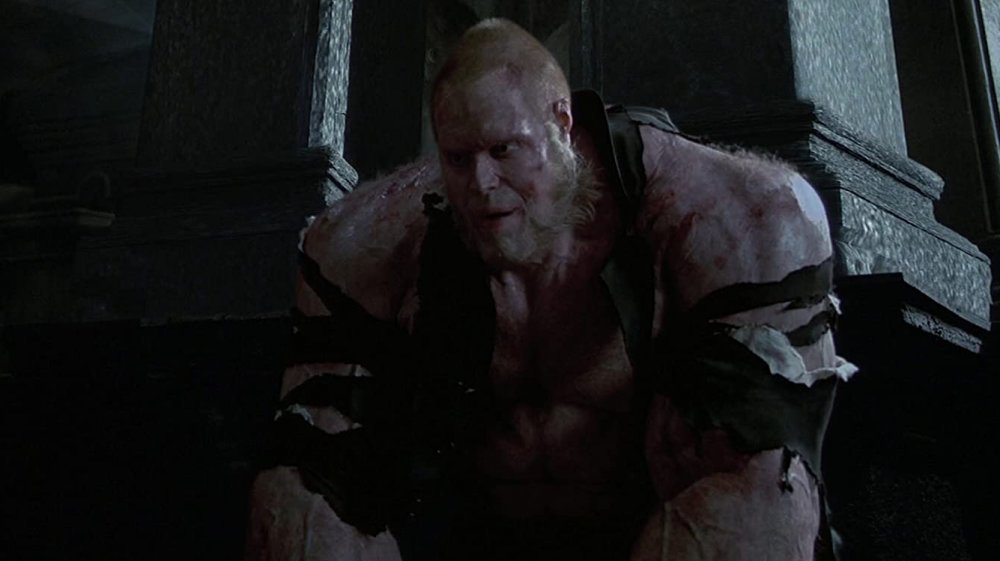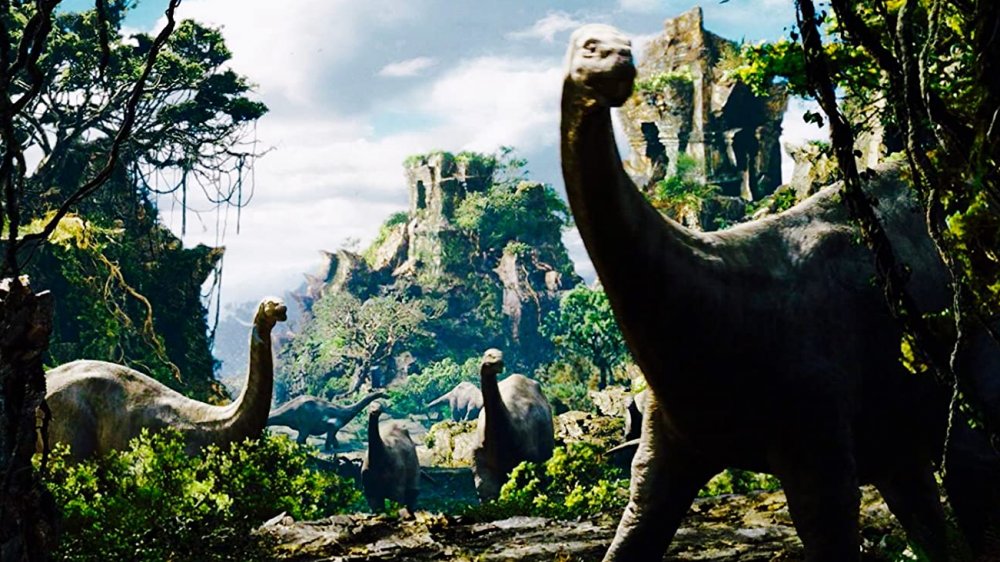Terrible Special Effects In Popular Horror Movies
Much like science fiction and fantasy movies, horror movies ask viewers for the ultimate suspension of disbelief. Thankfully, some crafty horror filmmakers throughout cinematic history have contributed lots of effective psychological trickery, dating back as far as the films from such late greats as James Whale, Alfred Hitchcock, George A. Romero, and Wes Craven, and carried on over the years through the likes of John Carpenter, James Wan, Sam Raimi, and more recently, Jordan Peele. Thanks to these fabulous directors and so many others, the phrase "It's only a movie" has been uttered under the breath of audience members millions of times, whether in theaters or the comforts (and ultimately, discomforts) of their own living rooms.
The "It's only a movie" phrase, however, does have its limitations, especially when some hokey special effect is splattered on big screen and nearly ruins the entire movie watching experience. In an effort to exorcise our memories of such horrid failures, we're here to relive some of the most terrible special effects in horror movies. It should be noted that these are not cheap shots at notoriously bad horror movies (or so-bad-they're-good horror movies), such as anything from the catalog of the late great schlockmeister Ed Wood or purposefully cheesy fare like the Sharknado or Toxic Avenger movies. No, these are unforgivable instances when for whatever reason, studios and filmmakers simply should have known better.
The talking goat: Drag Me to Hell
After taking a long break from horror to helm the Spider-Man trilogy among other films, Sam Raimi returned to direct a picture in the genre that helped him make his name with 2009's Drag Me to Hell. Overall, the film — about a loan officer named Christine (Alison Lohman) cursed to a destiny in Hell after denying a destitute elderly woman (Lorna Raver) a third extension on her mortgage — is a respectable thrill ride that contains several signature Raimi moments, especially when he introduces demonically possessed characters reminiscent of Evil Dead Deadites. However, there is a diversion in the third act that threatens to put the film out to pasture, so to speak, when a talking goat rears its ugly head at a séance.
The presence of the goat on paper seems to make sense — the séance was devised so Christine could pass the curse onto the animal — but instead, another evil entity possesses it and the special effects fiasco begins. What ensues is a few seconds of the goat spewing hatred toward Christine before biting the hand of (and thus passing on the evil to) another séance attendee. It's hard to say whether going the CGI route for the scene would have been any better, but as it stands, the mechanical talking goat is so fake looking and horribly out of place that it's laughable. It could have been worse, though, as the scene ended by the possessed séance attendee puking up a dead cat. Good times!
Animatronic wolf howling: Wolf
Perhaps one of the most interesting forays into the horror genre came in 1994 when director Mike Nichols — yes, Mike "The Oscar-winning director of The Graduate" Nichols — took the helm of and co-wrote Wolf, starring Jack Nicholson and Michelle Pfeiffer. It was an uncharacteristic turn for the dramatic and sometimes comedic film director, but a highly effective one as he gets the beast to come out in Nicholson's New York publishing house character who finds a new lust for life after he's bitten by a werewolf.
For the most part, Nichols goes the minimalist route with his leading man when it comes to his scenes as a lycanthrope, basically giving Nicholson a set of fangs, creepy contact lenses to yellow out his eyes, and additional facial hair around the jawline and chin to make sure we still know Jack. What we don't know is that near the end of the film's climactic third act, Nicholson's final transformation into a hairy beast isn't to make him a wolf... man, but an actual wolf.
If that wasn't disappointing enough for fans who wanted to see Jack in full werewolf makeup, a la Lon Chaney in any of his Universal Wolfman movies, instead for a couple seconds we get an animatronic wolf as Nichols pulls back a shot that begins with a closeup of the wolf's eyes and ends as we see what's supposed to be a creature tilt its head back to let off a howl to call his future mate (Pfeiffer). The unnatural-looking, Z-grade effect is laughable, considering that Nichols surely had enough money at his disposal to come up with something more realistic than what looks like a nature park exhibit for elementary school kids.
Sparkling Edward: Twilight
No list about terrible special effects in a horror movie (or in this case a horrible horror/romance movie) would be complete without a bloodletting of the frustrations viewers felt with the release of the first film in The Twilight Saga, the vampire romance that made superstars out of Robert Pattinson and Kristen Stewart. Pattison is Edward, a member of Cullen vampire clan who eventually brings the human Bella (Stewart) into his fanged family's fold.
While the film is rife with bad special effects, the scene when Edward reveals himself as a vampire in the sunlight to Bella is among the worst, as he shows how his body sparkles (which apparently somehow proves he's a vampire). But instead of something like a diamond-like sheen to cover his body, Edward's "sparkles" basically look like water droplets after he gets out of dip in a lake. The whole idea is not only ridiculous from a narrative standpoint (aren't vampires supposed to go "poof" in the sunlight?), it's just such a flat reveal. If anything, the filmmakers could have used the special effects money they didn't spend on the sparkling scene to superimpose some emotion onto Bella's face once in a while,.
CGI Scorpion King: The Mummy Returns
Released in 2001, director Stephen Sommers' The Mummy Returns, the smash sequel to his 1999 blockbuster The Mummy, is remarkable for two reasons. First, it marks the big-screen debut of WWE star Dwayne "The Rock" Johnson; second, the film produced one of the worst CGI sequences in a 20-year span.
Johnson appears in a prologue in The Mummy Returns that introduces his character, the Scorpion King, who returns in the third act as hybrid human/scorpion to take on the film's hero, the swashbuckling world adventurer Rick O'Connor (Brendan Fraser). The scorpion part of the character looks realistic enough, it's just that the human portion — the part that really matters — looks like a bad video game rendering of the Rock. The weird part of the scene, though, is that it intercuts with an epic battle between O'Connor's buddy Ardeth Bay (Oded Fehr) and his fellow swordsmen with Anubis' Army in the desert, where the visual effects are top-notch (at least for their day). But the minute the scene cuts back to the CGI Scorpion King, the stark difference in quality makes what's supposed to be a scary character laughable.
Werewolf transformation: Van Helsing
Three years after his CGI version of the Rock crumbled in The Mummy Returns, director Stephen Sommers booked Hugh Jackman a one-way ticket to visual effects mediocrity with Van Helsing. Jackman stars as the title character, the famed monster hunter who not only vanquishes evil but, in a story twist, is bitten by a werewolf (Will Kemp) and thus cursed to turn into the beast himself.
The transformation into the lycanthrope happens when all these big transformations are set to take place — in the third act — where generally filmmakers place most of their visual effects eggs in one basket. But since Van Helsing is a monster mash that also features other famed creatures like Frankenstein's monster (Shuler Hensley) and Dracula (Richard Roxburgh), as well as the Brides of Dracula (Elena Anya, Josie Moran and Silvia Colloca) who turned into winged harpies, there's a high demand for visual trickery throughout.
Given the liberty to reimagine the Universal Monsters universe with his Mummy films and Van Helsing, Sommers appeared to paint himself into a corner with his werewolf transformations. Instead of the traditional man growing wolf hair, Sommers' version of the Wolfman called for Van Helsing to shed his skin, which underneath revealed a much larger and hairier beast. But instead of the flesh tearing away, the cheap effect looks like skin melting off the creature. This is supposed to be the Wolfman, after all — not the melting Wicked Witch of the West in The Wizard of Oz.
Shark attack/explosion: Jaws 3D
Steven Spielberg's great white shark thriller Jaws ushered in the era of the summer blockbuster, so film audiences had every right to scrutinize every sequel that the film series spawned. As such, director Jeannot Szwarc delivered a decent second installment, but somebody at the studio level should have had the good sense of reeling in the shark attack idea from there since the sequel pulled in $102 million at the domestic box office — far less than the original's tally of $260.6 million stateside (a monstrous take considering it was released in the mid-'70s).
Throwing caution to the wind and hopping on the resurgence of the 3D film craze in the early 1980s, Universal Studios proceeded with a threequel and hired director Joe Alves for 1983's Jaws 3D, a seemingly logical move since he was the production designer on the previous two Jaws films. Let's just say things didn't quite work out since this was Alves' first — and last — directing gig (which earned him a Worst Director Razzie nomination).
Jaws 3D hit its low mark during the not-so-thrilling conclusion of the film, as the film's talented cast (including Dennis Quaid and Louis Gossett Jr.) feigned fright (in cheesy slow motion, no less) as a virtually motionless great white (which looks superimposed on the screen, apparently to help achieve the 3D effect) "smashes" through the glass window of an underwater control room for a theme park in perhaps one of the silliest sequences ever filmed in 3D. There's more, though, as Quaid manages to blow up the shark with a grenade, creating an explosion of blood followed by various parts of the beast including parts of the shark's jaw, which freeze in the frame suddenly — another of the film's miserable 3D effects.
Bad to the bone: Piranha 3D
A reboot of the Piranha horror film series that began in 1978, the 2010 horror comedy Piranha 3D featured several notable actors, including Jaws star Richard Dreyfuss. Also, among them was Jerry O'Connell, whose character met a gruesome ending in a scene that highlighted not one, but two laughable special effects.
The scene in question finds a boat ramming into some rocks, sending O'Connell who plays Derrick, a slimy pornographer, and Crystal (Riley Steele) sailing off the deck and into piranha-infested waters. Crystal is immediately devoured head to toe, with the prehistoric fish feast ending with the piranha emerging from her mouth in unconvincing CGI fashion. As for Derrick's demise, director Alexandre Aja went with some practical effects, as the flesh from his entire lower half was stripped to the bone. Not only do his bloody remains look ridiculous, superimposed piranha are being swatted away (another necessary evil needed to achieve the 3D effect). In an attempt to distract viewers from the bloody mess (both literally and figuratively), O'Connell delivers the line, "They took my penis" before perishing. The groaner of a one-liner makes an already painful scene even more painful to watch.
Head games: The Faculty
Although she's better known for roles like Bond girl Xenia Onatopp opposite Pierce Brosnan's 007 in 1995's GoldenEye and the statuesque mutant Jean Grey in 2000's X-Men, Famke Janssen has also carved out some time to take part in a few horror projects, from such films as Clive Barker's Lord of Illusions and the 1999 remake of The House on Haunted Hill to the bloody great Netflix series Hemlock Grove, which also starred the future Pennywise the Dancing Clown, Hollywood It-guy Bill Skarsgård.
Janssen has also had few missteps in her career, although she can't exactly be blamed for a goofy scene in director Robert Rodriguez's alien horror thriller The Faculty. The scene involves Janssen's alluring high school teacher Miss Elizabeth Burke, who attempts to attack the rebellious student Zeke Tyler (Josh Hartnett) while he's trying to flee from her in his car. Zeke manages to crash his vehicle in a way that cuts off Miss Burke's head, which, as it turns out, is attached to a tentacled creature. The result is mismatched CGI shot in which Janssen's clearly superimposed head looks barely attached to the tentacles. Meanwhile, the rest of her body is ambling around, looking to reattach its missing noggin. As clumsy as it is, at least the body looks real, but it can't make up for the poorly executed effects.
Hulking Mr. Hyde: The League of Extraordinary Gentlemen
Frederic March famously introduced the film world to author Robert Louis Stevenson's classic tale Dr. Jekyll and Mr. Hyde in 1931, in which a potion turned a clean-cut doctor into his hairy, Cro-Magnon-ish alter ego. Several iterations of the tale have been produced since then, but none more baffling than the hulking mess that was Mr. Hyde in 2003's The League of Extraordinary Gentlemen.
While technically not a horror film, League — which unites several notable fantasy and sci-fi characters for a secret mission — also includes some prominent horror figures, including Dr. Jekyll/Mr. Hyde (Jason Flemyng), Mina Harker (Peta Wilson) and Dorian Gray (Stuart Townsend). Hyde is offered amnesty for joining the group, and while his CGI appearance is passable for the day, the character looks horribly out of place standing next to human actors, including Sean Connery.
Worse yet, when one of the bad guys, Dante (Max Ryan), ingests more than he should of the doctor's potion, he turns into a grotesque creature and engages in battle with Hyde that is as cartoonish and silly as it gets. Side note: A year later, Van Helsing featured an appearance by another muscle-bound Mr. Hyde (Robbie Coltrane), which looked even worse than The League's version.
Cat Attack: Let the Right One In
A creepy vampire thriller, the 2008 Swedish film Let the Right One In not only paid dividends for director Tomas Alfredson (who went on to helm the excellent spy thriller Tinker, Tailor, Soldier, Spy), it spawned director Matt Reeves' 2010 English remake (retitled Let Me In) starring Chloe Grace Moretz and Kodi Smit-McPhee.
While Let the Right One In was compelling enough to earn awards or nominations from the likes of BAFTA, the National Board of Review, the Tribeca Film Festival and several critics organizations in the U.S., clearly voters let the film's infamous "cat attack" scene slide. Whether it was for the lack of a visual effects budget or the art department's secret affinity for The Muppets, Alfredson amazingly OK'd a scene in which supporting character Virginia (Ika Nord) is attacked by felines which are clearly puppets. The scene starts with real cats, of course, which makes the transition to their furry stand-ins seem all the more lifeless.
Dinosaur stampede: Peter Jackson's King Kong
Talk about one for the "no excuses" department. When Peter Jackson directed his grand remake of King Kong in 2005, he had the cinematic world at his disposal. Coming off his sweep of the Oscars for The Lord of the Rings: The Return of the King, Universal Studios reportedly gave Jackson a $207 million budget to work with, and yet King Kong's return to the big screen featured one of the most embarrassing special effects scenes in recent memory.
Thankfully, the scene didn't involve King Kong himself, who was brought to life with the brilliant motion capture work of Andy Serkis. Instead, it involved a smattering of human characters played by the likes of Adrien Brody, Jack Black and Kyle Chandler, who find themselves in the path of a dinosaur stampede that is green screen filmmaking at its very worst. The dinosaurs look fake and out of place, and it's clear the actors are reacting to a bunch of tennis balls rather than prehistoric creatures ready to stamp the life out of them. You have to remember, CGI effects were hardly in their infancy at this point, especially considering the realism of the dinosaurs in Jurassic Park a dozen years before.
Amazingly, the otherwise terrific artisans at WETA won the Best Visual Effects Oscar for their work on King Kong, presumably because of Serkis' mo-cap work.
Every werewolf scene: An American Werewolf in Paris
Watching the atrocious visual effects in 1997's An American Werewolf in Paris is especially painful considering the landmark effects of its predecessor, director John Landis' 1981 horror classic An American Werewolf in London.
The original film earned makeup maestro Rick Baker the first-ever Oscar awarded for Best Makeup, a statuette largely earned to the innovative practical effects he used to transform lead character David (David Naughton) into a lycanthrope. Sixteen years later, however, director Anthony Waller cast practicality to the wayside in favor of CGI, and the half-rendered-looking results are cartoonish and chaotic. How Waller thought an emerging visual effects field could best Baker's stunning work on the original American Werewolf shall remain one of the biggest mysteries of all time.
